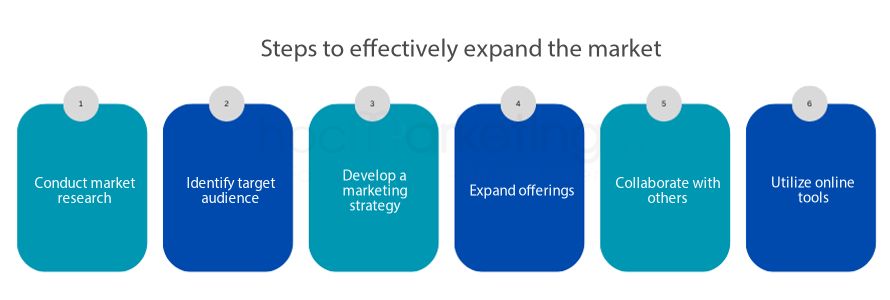
What is market expansion? Steps to effectively expand the market

Learn how to expand your market effectively with our step-by-step guide. Discover the benefits of market expansion, how to conduct market research, identify your target audience, develop a marketing strategy, and more. Overcome common challenges and discover best practices with our case studies.
Market expansion is a crucial factor for any business to grow and thrive. It involves identifying new opportunities and effectively reaching out to potential customers in different markets. However, successfully expanding your market is not an easy feat to accomplish. It requires careful planning, research, and execution. In this blog post, we will delve into the concept of market expansion, reasons for its importance, and provide a step-by-step guide on how to effectively expand your market. We will also discuss common challenges that businesses face during market expansion and provide best practices for successful expansion. Additionally, we will showcase some case studies of companies that have successfully expanded their markets. By the end of this post, you will have a comprehensive understanding of what market expansion is and how to execute it effectively.
1. What is Market expansion?
Market expansion refers to the process of growing a business by increasing its reach to new markets. It involves identifying opportunities to sell products or services to new customers beyond the existing customer base. This can be done by introducing new products or services, targeting new geographic locations, or reaching out to new customer segments. Market expansion is a key growth strategy for businesses looking to increase revenue and profitability. In this article, we will explore the reasons for market expansion, steps to effectively expand the market, common challenges, best practices, and case studies of successful market expansion.
2. Reasons for market expansion
Market expansion is a strategy adopted by businesses to increase their customer base and reach new markets. There are several reasons why businesses may choose to expand their market. Firstly, expanding the market can help businesses increase their revenue and profitability. By reaching new customers and markets, businesses can increase their sales and profits. Secondly, market expansion can help businesses reduce their dependence on a single market or product. This can help businesses mitigate risks associated with market fluctuations or changes in consumer preferences. Thirdly, market expansion can help businesses stay competitive and maintain their market position. By expanding their product or service offerings, businesses can attract new customers and retain existing ones. Finally, market expansion can help businesses take advantage of emerging trends and opportunities in new markets. By identifying new opportunities and adapting to changing market conditions, businesses can remain relevant and grow over time.
3. Steps to effectively expand the market
To effectively expand your market, there are several steps that you need to take. First, conduct market research to gain a better understanding of your current market and identify potential areas for growth. This can include analyzing customer demographics, market trends, and competitors.
Once you have a clear understanding of your market, identify your target audience and develop a marketing strategy to reach them. This may involve creating targeted advertising campaigns or developing partnerships with other businesses to reach a broader audience.
Expanding your product or service offerings is another effective way to expand your market. This can involve developing new products or services that appeal to your existing customer base or branching out into new markets altogether.
Collaborating with other businesses can also be a powerful tool for expanding your market. This can involve partnering with complementary businesses to offer bundled products or services, or developing strategic partnerships to reach new audiences.
Finally, it is important to utilize online marketing tools to expand your reach and connect with customers. This can include developing a strong social media presence, optimizing your website for search engines, and investing in paid online advertising.
By following these steps, businesses can effectively expand their market and reach new audiences, driving growth and increasing revenue.
Conduct market research
Conducting market research is an essential step in expanding the market. It involves collecting and analyzing data about the market, including customer demographics, preferences, and behaviors, as well as industry trends and competitors. By conducting market research, businesses can identify opportunities for growth and make informed decisions about their marketing strategies.
One of the first things businesses should do when conducting market research is to define their target audience. This involves identifying the characteristics of their ideal customer, such as age, gender, income level, and interests. This information can be gathered through surveys, focus groups, or other methods of data collection.
Once the target audience has been defined, businesses can begin to gather data about their preferences and behaviors. This can include analyzing social media trends, conducting surveys, or studying customer reviews. By understanding what their customers want and need, businesses can develop products and services that meet those needs.
Another important aspect of market research is studying industry trends and competitors. This can involve analyzing data about the size of the market, the level of competition, and the strategies that competitors are using to succeed. By staying up-to-date on industry trends and understanding what their competitors are doing, businesses can identify opportunities for growth and develop effective marketing strategies.
Overall, conducting market research is a crucial step in expanding the market. By gathering and analyzing data about the market, businesses can identify opportunities for growth and develop effective marketing strategies to reach their target audience.
Identify target audience
Identifying the target audience is a crucial step in market expansion. Without a clear understanding of who your ideal customer is, it can be difficult to effectively market your product or service. To begin identifying your target audience, start by analyzing your current customer base. Look at demographics such as age, gender, location, and income to get a sense of who is already buying from you.
Once you have a clear understanding of your current customers, use that information to develop buyer personas. These are fictional representations of your ideal customer, including their demographics, interests, and pain points. By creating detailed buyer personas, you can tailor your marketing efforts to better resonate with your target audience.
Another important aspect of identifying your target audience is understanding their needs and preferences. Conducting market research and gathering feedback from existing customers can provide valuable insights into what your target audience is looking for. Use this information to refine your product or service offerings and develop marketing messages that speak directly to their needs.
Ultimately, the key to identifying your target audience is to stay focused on their needs and preferences. By understanding who your ideal customer is and what they are looking for, you can create more effective marketing campaigns and ultimately drive business growth through market expansion.
Develop a marketing strategy
Developing a marketing strategy is a crucial step in expanding your market. A well-crafted marketing strategy can help you reach your target audience, increase brand awareness, and ultimately drive sales. The first step in developing a marketing strategy is to identify your target audience. Who are your ideal customers? What are their needs and pain points? Once you have a clear understanding of your target audience, you can start to craft your messaging and choose the right marketing channels to reach them.
Your marketing strategy should also take into account your unique value proposition. What sets your product or service apart from your competitors? What benefits do you offer that your target audience can't find elsewhere? Highlighting these unique selling points in your marketing messaging can help you stand out in a crowded marketplace.
Another important aspect of your marketing strategy is choosing the right marketing channels. This can include both traditional marketing channels, such as print advertising and direct mail, as well as digital marketing channels like social media, email marketing, and search engine optimization (SEO). Choosing the right marketing channels will depend on your target audience and your budget.
Finally, it's important to measure the effectiveness of your marketing strategy and make adjustments as needed. This can include tracking website traffic, social media engagement, and sales data to see what's working and what's not. By continuously refining your marketing strategy, you can ensure that you're reaching your target audience and driving business growth.
Expand product or service offerings
When expanding into new markets, it may be necessary to consider adding new products or services to your offerings. This allows you to meet the needs of a wider range of customers and differentiate yourself from competitors. However, before expanding your offerings, it is important to conduct market research and identify the needs and preferences of your target audience. This will help ensure that any new products or services will be well-received and successful.
Expanding your offerings can be done in a variety of ways. You may choose to develop new products or services in-house, or you may opt to acquire them through partnerships or acquisitions. You may also consider licensing or franchising your products or services to third-party businesses. Whatever approach you choose, it is important to ensure that any new offerings align with your overall business strategy and brand values.
When introducing new products or services, it is also important to consider the pricing strategy. You may need to adjust your pricing to remain competitive in the new market, while also ensuring that your margins remain healthy. Additionally, you will need to develop a marketing plan that effectively promotes your new offerings and highlights their unique benefits.
Expanding your offerings can be a powerful way to drive growth and increase revenue. By carefully considering market needs and preferences, developing a strong marketing plan, and strategically introducing new products or services, you can successfully expand your business into new markets.
Collaborate with other businesses
Collaborating with other businesses is an effective way to expand your market reach. By partnering with other businesses, you can tap into their customer base and offer complementary products or services. This can lead to increased visibility and sales for both businesses involved.
One way to collaborate with other businesses is to create joint marketing campaigns. This can include co-branded advertising, social media promotions, or email marketing campaigns. By working together, both businesses can benefit from increased exposure and reach.
Another way to collaborate is to offer bundled services or products with another business. For example, a restaurant could partner with a local movie theater to offer a dinner and movie package. This can help attract new customers and provide added value to existing ones.
Additionally, businesses can collaborate by sharing resources or expertise. For example, a small business that specializes in social media marketing could partner with a larger business that has a strong email marketing program. By sharing knowledge and resources, both businesses can improve their overall marketing efforts.
Overall, collaborating with other businesses can be a valuable strategy for expanding your market reach. By working together, businesses can tap into new customer bases, offer added value to existing customers, and share knowledge and resources to improve their overall marketing efforts.
Utilize online marketing tools
To effectively expand the market, businesses must leverage the power of online marketing tools. The digital landscape has transformed the way companies interact with customers, making it essential to have a strong online presence. Utilizing online marketing tools can help businesses reach a wider audience, generate leads, and increase revenue. Some of the most effective online marketing tools include search engine optimization (SEO), social media marketing, email marketing, pay-per-click (PPC) advertising, and content marketing.
SEO is the process of optimizing a website to rank higher in search engine results pages (SERPs). By optimizing website content and structure, businesses can attract more organic traffic, boost visibility, and improve website credibility. Social media marketing involves creating and sharing content on social media platforms such as Facebook, Twitter, and Instagram to engage with customers and promote products or services. Email marketing is another effective tool that involves sending promotional emails to subscribers to build relationships and increase sales.
PPC advertising is a paid online advertising model that allows businesses to bid for ad placement on search engine results pages, social media platforms, and other websites. With PPC, businesses only pay when a user clicks on their ad. This makes it a cost-effective way to reach a targeted audience. Content marketing involves creating and sharing valuable and relevant content to attract and retain a clearly defined audience, with the ultimate goal of driving profitable customer action.
By utilizing these online marketing tools, businesses can effectively expand their market and reach a wider audience. However, it is essential to develop a clear marketing strategy that aligns with business goals and target audience preferences. It is also important to regularly monitor and measure the effectiveness of marketing campaigns to optimize results and ensure a positive return on investment.
4. Common challenges in market expansion
Expanding a business into a new market is not an easy task. There are several challenges that companies face during this process. One of the common challenges is the lack of understanding of the new market. Companies need to conduct thorough market research to understand the market demand, competition, cultural differences, and other relevant factors. Without proper research, companies may end up offering products or services that are not suitable for the new market.
Another challenge is the lack of resources. Expansion requires a significant investment of time, money, and effort. Companies need to be prepared for the costs associated with market expansion. They need to allocate resources for marketing, product development, distribution, and other activities. If companies do not have the necessary resources, they may struggle to penetrate the new market.
Moreover, legal and regulatory issues can be a major challenge for companies seeking to expand their business. Laws and regulations vary from country to country, and companies need to comply with local laws to avoid legal issues. In some cases, companies may need to obtain permits, licenses, or certifications to operate in the new market. Failure to comply with regulations can result in fines, legal action, or even closure of the business.
Finally, cultural and language barriers can also pose a challenge for companies expanding into a new market. Companies need to understand the local culture, language, and customs to effectively communicate with customers and stakeholders. Failure to do so can result in misunderstandings, miscommunication, and a negative impact on the brand.
In summary, market expansion is a complex process that requires careful planning, research, and execution. Companies need to be aware of the challenges they may face and develop strategies to overcome them. By addressing these challenges, companies can successfully expand into new markets and achieve their business objectives.
5. Best practices for successful market expansion
To ensure successful market expansion, it is important to follow some best practices that have been proven to work for many businesses. One of the most important practices is to have a clear understanding of your target audience. Conducting market research can help you identify the needs and preferences of your target audience, which can help you tailor your marketing strategy to their specific needs. This, in turn, can increase your chances of success in the market.
Another best practice is to develop a marketing strategy that is aligned with your business goals. This can involve using a mix of traditional advertising methods, such as print and radio ads, as well as newer online marketing tools, such as social media and email marketing. It is also important to regularly review and adjust your marketing strategy based on the results you are seeing.
Expanding your product or service offerings can also be an effective way to expand your market. This can involve adding new products or services that complement your existing offerings, or creating entirely new products or services that meet the needs of your target audience. Collaborating with other businesses can also be a great way to expand your reach and expose your brand to new audiences.
However, it is important to keep in mind that there may be common challenges and obstacles that you will face when expanding your market. These can include increased competition, difficulty in reaching new audiences, and the need to continually adapt to changing market conditions and consumer preferences. By staying flexible and responsive to these challenges, you can increase your chances of success in the market.
In summary, best practices for successful market expansion include understanding your target audience, developing a clear marketing strategy, expanding your product or service offerings, collaborating with other businesses, and staying flexible and responsive to changing market conditions. By following these practices, you can increase your chances of success and effectively grow your business in new markets.
6. Case studies of successful market expansion
In this section, we will look at some real-life case studies of successful market expansion. These examples will help us better understand how companies have used different strategies to expand their market share and increase their profits.
One example of successful market expansion is Starbucks, which is now a global brand with over 30,000 stores in 78 countries. Starbucks started as a single coffee shop in Seattle, Washington in the 1970s. However, the company's rapid growth began in the 1990s when it started expanding into new markets outside the US. Starbucks employed a strategy of adapting to local tastes while maintaining its core values and brand identity. For example, in China, Starbucks introduced tea-based drinks to cater to local preferences. Starbucks' success can be attributed to its well-executed expansion strategy and its ability to innovate and adapt to changing market conditions.
Another example of successful market expansion is Amazon, which started as an online bookstore in 1994 and has now become one of the world's largest online retailers. Amazon's success can be attributed to its ability to diversify its product offerings and expand into new markets. For example, Amazon started selling electronics, clothing, and other consumer goods, and also expanded into cloud computing with Amazon Web Services. Amazon's expansion strategy was based on customer-centricity, which means focusing on the needs and preferences of customers. Amazon's success can be attributed to its ability to leverage technology to improve the customer experience and increase operational efficiency.
A third example of successful market expansion is Apple, which started as a computer company in the 1970s and has now become a global brand with a range of products and services. Apple's success can be attributed to its ability to develop innovative products and services and build a loyal customer base. Apple's expansion strategy was based on product innovation, which means introducing new products and services that meet the needs and preferences of customers. For example, Apple introduced the iPhone, iPad, and Apple Watch, which have become iconic products in their respective markets. Apple's success can be attributed to its ability to create a strong brand identity and a loyal customer base.
These case studies demonstrate that successful market expansion requires a well-executed strategy, a customer-centric approach, and the ability to innovate and adapt to changing market conditions. Companies that are able to effectively expand their market share can increase their profits and create long-term value for their stakeholders.
Summary
In conclusion, market expansion is a crucial step for businesses looking to grow and increase their revenue. It involves identifying new target markets, developing a strategy, and executing it effectively. By following the steps outlined in this post, businesses can successfully expand their market and reach a wider audience. Remember to constantly analyze and adjust your approach to ensure the best possible outcome. With dedication and hard work, market expansion can lead to increased success and profitability for your business.















